- Home
- »
- Medical Devices
- »
-
Mammography Market Size, Share & Growth Report, 2030GVR Report cover
![Mammography Market Size, Share & Trends Report]()
Mammography Market Size, Share & Trends Analysis Report By Product (Film Screen, Digital), By Technology (Breast Tomosynthesis, Digital), By End-use, By Region, And Segment Forecasts, 2024 - 2030
- Report ID: GVR-1-68038-353-9
- Number of Report Pages: 120
- Format: PDF, Horizon Databook
- Historical Range: 2018 - 2022
- Forecast Period: 2024 - 2030
- Industry: Healthcare
Mammography Market Size & Trends
The global mammography market size was valued at USD 2.35 billion in 2023 and is projected to grow at a CAGR of 8.87% from 2024 to 2030. The rising prevalence of breast cancer and increasing demand for early-stage diagnosis amongst patients are some of the key factors anticipated to drive demand for breast cancer diagnostic devices over the forecast period. Increased access to breast cancer screening systems and growing government initiatives to support clinical interpretation are some of the pivotal factors expected to propel market growth. The demand for mammography screening services is on the rise due to the increasing prevalence of breast cancer among the geriatric population. Furthermore, as the world's population is growing, a large proportion of women might reach the age of 60 years or older. Women over the age of 60 years account for about 78% of all breast cancer-related fatalities.
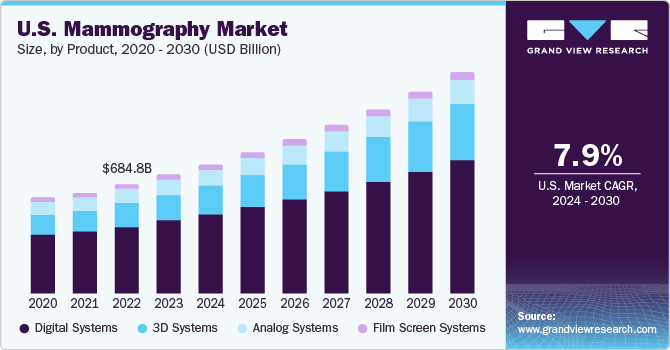
Breast cancer has a high incidence and fatality rate in this age range, indicating a significant unmet demand for breast cancer diagnostics. The need for mammography is likely to rise as the number of events and fatalities rises. Thus, the increasing geriatric population is expected to propel market growth over the forecast period. The introduction of new products is expected to boost the adoption rate among end-users. Earlier generations of mammography systems provided 2D breast images, limiting the interpretation quality. 2D mammography systems provide Craniocaudal (CC) and Mediolateral-Oblique (MLO) images. The flat nature of these images makes it difficult for physicians to interpret images and identify tumors due to the overlapping of tissues and calcifications, which masks cancerous lesions.
With the introduction of new 3D-based technology called Digital Breast Tomosynthesis (DBT), obtaining a 3D image of the breast is possible. This allows radiologists to scan the breast slice by slice and identify abnormalities, which would be obscured in 2D images. Furthermore, the high demand for mammography screening services can be attributed to the improvement in accuracy & efficiency provided by advanced technologies, such as digital mammography, 3D mammography (tomosynthesis), and computer-aided detection (CAD). For instance, in November 2023, GE HealthCare unveiled a new product, the MyBreastAI suite, at the RSNA 2023 conference in Chicago. The AI-powered suite aims to streamline radiologists' workflows and aid in the early detection of breast cancer. These advancements in mammography technology drive the demand for mammography products.
Market Concentration & Characteristics
Market growth stage is high, and the pace of its growth is accelerating. The market is characterized by a high degree of innovation owing to new technologies that have been developed to improve the effectiveness and accuracy of mammography. For instance, incorporating AI algorithms into mammography systems for image analysis, streamlining workflows, and assessing risks stands as a notable innovation in the field. These AI-driven solutions have the potential to elevate diagnostic precision and streamline processes, ultimately resulting in better patient outcomes
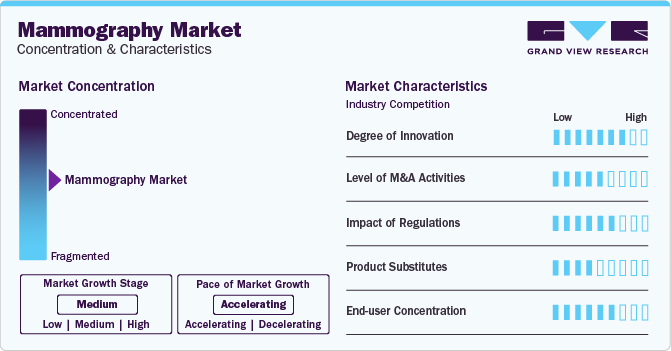
The mammography market is also characterized by a high level of merger and acquisition (M&A) activities by the leading players. Key players in the market are acquiring small- and medium-sized manufacturers of mammography to expand their product portfolios and increase their industry share
The market has been experiencing growing regulatory scrutiny. Government bodies, such as the FDA and the European Medicines Agency, have set up strict regulations to ensure the safety and effectiveness of mammography devices. The mammography market heavily relies on regulations to ensure that mammography services are of high quality, safe, easily accessible, and affordable. These regulations also contribute significantly to the effectiveness of early detection and screening efforts for breast cancer. Compliance with these regulations is crucial for all stakeholders in the market to maintain patient trust, follow best practices, and achieve positive health outcomes
There are various substitutes for mammography. Some of the commonly used alternatives include breast ultrasound, magnetic resonance imaging (MRI), contrast-enhanced mammography (CEM), automated breast ultrasound (ABUS), breast thermography, and clinical breast examination (CBE). These products may provide similar benefits to mammography
The global market is significantly affected by the concentration of end-users. The market has seen a growing demand from end-users, such as hospitals, specialty clinics, and diagnosis centers. The increasing prevalence of breast cancer and the growing geriatric population have led to a rise in the demand for mammography
Product Insights
In terms of product, the digital systems segment dominated the market with a revenue share of more than 60.19% in 2023 and is expected to witness considerable growth over the forecast period. Many organizations took decisive measures to manage these diseases because breast cancer patients are at a higher risk of contracting the infection. According to a study published in Medicina Clínica Journal in September 2020 by Dafina Petrova et al., the European Society for Medical Oncology (ESMO), the Spanish Society of Radiation Oncology (SEOR), and the Spanish Society of Medical Oncology (SEOM) have published some guidelines on how to modify treatment protocols to minimize risks in cancer patients.
The enhanced guidelines might allow for more efficient surgical procedures, which would benefit treatments. Such occurrences are expected to contribute to the market growth. The 3D systems segment is anticipated to be the fastest-growing segment with a CAGR from 2024 to 2030 owing to various advantages of these systems, such as the ability to manage bigger procedure volumes, increased breast cancer detection rates, and a more advantageous reimbursement scenario. Hospitals & diagnostic clinics are switching to 3D systems as 2D systems are often ineffective in detecting every sign of cancer, increasing the need for additional screenings, which, in turn, increases the overall diagnostic cost. Furthermore, the trend of 3D mammography system leasing contract agreements is increasing.
Rental contract agreements allow end-users to pay a set fee for each 3D mammogram conducted utilizing 3D mammography technology provided by manufacturers at no cost. This enables low-income hospitals and diagnostic labs to implement this cutting-edge breast imaging technology. In addition, in recent years, some countries have implemented public mammography screening. In these public mammography screening programs, 3D mammography devices are employed to achieve the highest level of accuracy in the identification of breast cancer. Thus, the aforementioned factors are anticipated to contribute to the segment’s rapid growth in the coming years.
Technology Insights
The digital mammography technology segment accounted for the maximum revenue share of more than 66.27% in 2023 due to the various advantages of this technology. Digital mammography is a specialized and sophisticated form of mammography that examines breast tissue for the presence of cancers using digital sensors and computers rather than X-ray films. In most countries, conventional screen-film mammography (SFM) with high spatial resolution has been the preferred choice for screening programs. However, with the introduction of digital mammography, a growing number of countries are shifting toward these newer systems, owing to their superior depiction of low-contrast objects, wider dynamic change, and enhanced diagnostic quality of images, particularly when evaluating denser breasts.
Moreover, they also have the added benefit of soft-copy visual displays and soft-copy reading, both of which are easily transferable. Mammography screening is now digital in many nations, including the UK, providing greater precision, higher quality, and greater efficiency. As a result, digital mammography is becoming the standard screening method, even though the new equipment is six times more expensive than traditional systems. Furthermore, in comparison to analog systems, radiation exposure is reduced significantly. The most prevalent type of digital mammography used is full-field digital mammography. It has the potential to make substantial advancements in breast cancer diagnostics, such as lowering radiation doses, reducing breast compression pressure, and improving detection.
All these benefits will contribute to the segment’s growth over the forecast period. The breast tomosynthesis technology segment is expected to witness the fastest CAGR from 2024 to 2030. Digital breast tomosynthesis is a high-resolution limited-angle tomography technology that uses X-rays to create a 3-dimensional image of the breast. It is a new technique that aids in the identification of breast cancer in its early stages. Digital breast tomosynthesis is very useful in analyzing dense breasts and can enhance the ability to detect breast cancer. It minimizes the number of false-positive readings (readings that identify normal tissue as abnormal) and the necessity for a biopsy. It is especially good for examining dense breasts.
End-use Insights
The hospitals end-use segment dominated the market in 2023 with a revenue share of around 45.64%. The presence of mammography facilities within a hospital can positively affect various factors, such as duration of hospital stay, total healthcare cost, quality of care, and availability of emergency care. For instance, in May 2022, Merit Health Woman’s Hospital installed a new 3D specimen tomosynthesis imaging system, enhancing the ability of breast cancer surgeons to accurately visualize tumors during lumpectomy surgeries. Large hospitals usually have in-house mammography facilities; however, the requirement of ample space, skilled professionals, high investments, and frequent maintenance can act as an entry barrier. This can burden hospitals trying to manage their medical imaging facilities.
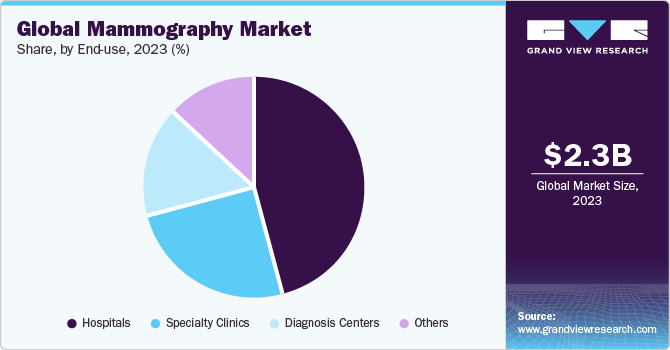
To reduce this burden and to increase the reach of their facilities & services, hospitals can partner up with diagnostic centers to provide medical imaging facilities. The diagnostic centers segment is expected to witness significant growth during the forecast period due to increased breast cancer awareness. This has accelerated the demand for mammography procedures used for diagnosis, treatment planning, and prevention of breast cancer. The availability of advanced mammography services in diagnostic centers of developed & developing economies, such as the U.S., Germany, the UK, Japan, China, and India, is expected to propel the overall segment growth.
Regional Insights
The mammography market in North America held the largest share of 35.80% of the global revenue in 2023. The rising incidence of breast cancer in the region is one of the major factors driving the market growth.According to the American Cancer Society, approximate 310,720 new cases of invasive breast cancer among women will be detected in 2024. Furthermore, 56,500 cases of in situ breast carcinoma in women have been discovered, and the number of breast cancer cases is predicted to rise in the coming years.
U.S. Mammography Market Trends
The U.S. mammography market held the largest share in the North America regional market in 2023 due to the high prevalence of breast cancer and the presence of key market players in the country. These factors are expected to drive the demand for mammography devices, thereby supporting market growth.
Europe Mammography Market Trends
The mammography market in Europe is driven by factors, such as the rising geriatric population and the presence of well-established healthcare infrastructure. For instance, as per a report by the European Union (EU) population, in January 2023, in Europe, more than 21.3% (448.8 million people) people out of the total EU population was aged 65 years and over in 2023. This is anticipated to drive the market.
The UK mammography market is expected to witness significant growth over the forecast period. The market growth can be attributed to the rising healthcare expenditure and geriatric population in the country.
The mammography market in France is anticipated to witness considerable growth in the coming yearsdue tothe presence of key players and increasing prevalence of breast cancer.
The Germany mammography market growth is driven by various factors including the presence of key players. Manylocalcompanies are forming strategic partnerships, launching new products, and engaging in mergers and agreements.
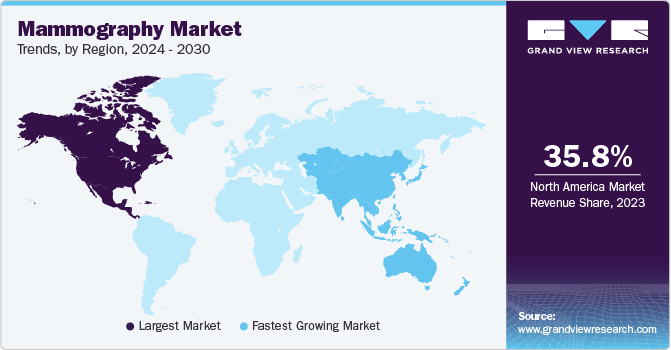
Asia Pacific Mammography Market Trends
The mammography market in Asia Pacific is anticipated to witness significant growth due to the increased prevalence of breast cancer, high R&D investments in breast cancer therapies, and developments in breast imaging modalities. Breast cancer is the most frequent malignancy in most Asian countries regardless of race or ethnicity, according to the Centers for Disease Control and Prevention (CDC). According to Breast Cancer ASIR 2020, the age-standardized incidence rate of breast cancer in Asia is 36.8 per 100,000 people. Thus, the increased prevalence of breast cancer and the region's expanding healthcare infrastructure are likely to fuel overall market growth.
The China mammography market accounted for the largest share of the Asia Pacific mammography market in 2023. Growth in the market is primarily propelled by the rising elderly population and the growing burden of breast cancer are factors expected to boost the demand for mammography in China in the coming years.
The mammography market in Japan is moderately competitive, with the presence of some major companies offering mammography. Major players in the market are adopting several strategies, such as mergers & acquisitions and partnerships & collaborations to stay competitive in the market.
Latin America Mammography Market Trends
The Latin America mammography market growth is driven by increased healthcare spending and the expansion of private healthcare facilities enabling more accessible mammography services, thus fueling market growth. In addition, the higher breast cancer risk among the aging population in Latin America is driving the demand for mammography screening services.
MEA Mammography Market Trends
The mammography market in MEA is expected to witness significant growth due to various factors, such as the increasing prevalence of breast cancer and initiatives led by governments to enhance breast cancer awareness & healthcare infrastructure, driving the demand for mammography screening services and equipment.
Key Mammography Company Insights
Top players are focusing more on user comfort through technological advancements and innovative products. Thus, advancements in technology and products support the overall market growth. Some prominent players in the mammography market include:
Key Mammography Companies:
The following are the leading companies in the mammography market. These companies collectively hold the largest market share and dictate industry trends.
- Hologic Inc.
- Analogic Corporation
- Canon Medical Systems Corporation
- Fujifilm Corporation
- Siemens Healthcare
- Toshiba Medical Systems
- GE Healthcare
- Metaltronica
- Koninklijke Philips NV
- PLANMED OY
Recent Developments
-
In September 2023, Siemens Healthineers introduced the Mammomat B.brilliant1, featuring wide-angle tomosynthesis. This innovative mammography system utilizes a wide 50° angle for tomosynthesis, the largest available in the market. With a scan time of approximately five seconds, it offers the fastest wide-angle tomosynthesis, generating high-depth resolution 3D images swiftly.
-
In November 2023, GE Healthcare launched the MyBreastAI Suite, aimed at enhancing breast cancer detection during mammography examinations and simplifying radiology workflows through artificial intelligence (AI) tools
-
In December 2023, RadNet, Inc. introduces MammogramNow, a pioneering screening mammography service scheduled to launch at the Walmart Supercenter in Milford, Delaware
Mammography Market Report Scope
Report Attribute
Details
Market size value in 2024
USD 2.58 billion
Revenue forecast in 2030
USD 4.67 billion
Growth rate
CAGR of 8.87% from 2024 to 2030
Base year for estimation
2023
Historical data
2018 - 2022
Forecast period
2024 - 2030
Report updated
April 2024
Quantitative units
Revenue in USD million and CAGR from 2024 to 2030
Report coverage
Revenue forecast, company ranking, competitive landscape, growth factors, and trends
Segments covered
Product, technology, end-use, region
Regional scope
North America; Europe; Asia Pacific; Latin America; MEA
Country scope
U.S.; Canada; Germany; UK; France; China; Japan; India; South Korea; Australia; Brazil; Mexico; UAE; South Africa
Key companies profiled
Hologic Inc.; Analogic Corp.; Canon Medical Systems Corp.; Fujifilm Corp.; Siemens Healthcare; Toshiba Medical Systems; GE Healthcare; Metaltronica; Koninklijke Philips NV; Planmed Oy
Customization scope
Free report customization (equivalent up to 8 analysts working days) with purchase. Addition or alteration to country, regional & segment scope.
Pricing and purchase options
Avail customized purchase options to meet your exact research needs. Explore purchase options
Global Mammography Market Report Segmentation
This report forecasts revenue growth at global, regional, and country levels and provides an analysis of the latest trends in each of the sub-segments from 2018 to 2030. For this study, Grand View Research has segmented the mammography market report based on product, technology, end-use, and region:
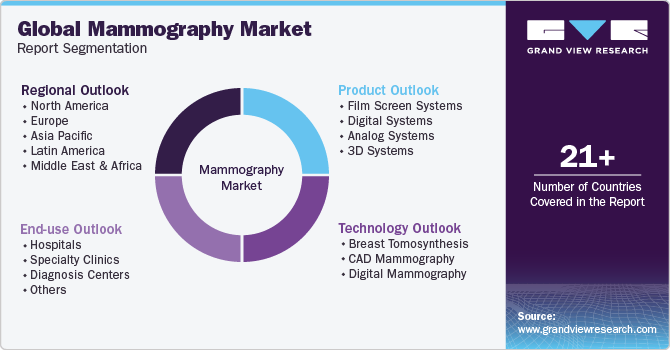
-
Product Outlook (Revenue, USD Million; 2018 - 2030)
-
Film Screen Systems
-
Digital Systems
-
Analog Systems
-
3D Systems
-
-
Technology Outlook (Revenue, USD Million; 2018 - 2030)
-
Breast Tomosynthesis
-
CAD Mammography
-
Digital Mammography
-
-
End-use Outlook (Revenue, USD Million; 2018 - 2030)
-
Hospitals
-
Specialty Clinics
-
Diagnosis Centers
-
Others
-
-
Regional Outlook (Revenue, USD Million, 2018 - 2030)
-
North America
-
U.S.
-
Canada
-
-
Europe
-
Germany
-
UK
-
France
-
Italy
-
Spain
-
Sweden
-
Denmark
-
Norway
-
-
Asia Pacific
-
Japan
-
China
-
India
-
Australia
-
South Korea
-
Thailand
-
-
Latin America
-
Mexico
-
Brazil
-
Argentina
-
-
Middle East & Africa
-
South Africa
-
Saudi Arabia
-
UAE
-
Kuwait
-
-
Frequently Asked Questions About This Report
b. The global mammography market size was estimated at USD 2.35 billion in 2023 and is expected to reach USD 2.58 billion in 2024.
b. The global mammography market is expected to grow at a compound annual growth rate of 8.87% from 2024 to 2030 to reach USD 4.67 billion by 2030.
b. North America dominated the mammography market with a share of more than 35.8% in 2023. This is attributable to the rising growing prevalence of breast cancer and an increase in the women population above 40 years.
b. Some key players operating in the mammography market include Hologic Inc., Analogic Corporation, Canon Medical Systems Corporation, Fujifilm Corporation, Siemens Healthcare, Toshiba Medical Systems, GE Healthcare, Metaltronica, Koninklijke Philips NV, and PLANMED OY
b. Key factors that are driving the mammography market growth include the rising prevalence of breast cancer, favorable government initiatives, and technological advancements.
Share this report with your colleague or friend.
![gvr icn]()
NEED A CUSTOM REPORT?
We can customize every report - free of charge - including purchasing stand-alone sections or country-level reports, as well as offer affordable discounts for start-ups & universities. Contact us now
![Certified Icon]()
We are GDPR and CCPA compliant! Your transaction & personal information is safe and secure. For more details, please read our privacy policy.
We are committed towards customer satisfaction, and quality service.
"The quality of research they have done for us has been excellent."





